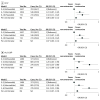Healthy Lifestyle and the Likelihood of Becoming a Centenarian
- PMID: 38900423
- PMCID: PMC11190803
- DOI: 10.1001/jamanetworkopen.2024.17931
Healthy Lifestyle and the Likelihood of Becoming a Centenarian
Abstract
Importance: Previous studies have reported that lifestyle factors were associated with life expectancy and/or mortality, but most of them studied the middle-aged or older age groups (aged ≥60 years), and few focused on people aged 80 years or older.
Objectives: To examine healthy lifestyle and the likelihood of becoming centenarians among people aged 80 years or older in China.
Design, settings, and participants: Using data from the Chinese Longitudinal Healthy Longevity Survey, a nationally representative and one of the largest prospective cohorts targeting people aged 80 years or older established in 1998, a community-based, prospective nested case-control study was performed. Data were analyzed from December 1, 2022, to April 15, 2024.
Exposures: A healthy lifestyle score for 100 (HLS-100, ranging from 0 to 6), including smoking, exercise, and dietary diversity, was constructed, with higher scores indicating potentially better health outcomes.
Main outcomes and measures: The primary outcome was survivorship to becoming a centenarian by 2018 (the end of follow-up). Information on sociodemographic characteristics, lifestyle factors, and other covariates was collected.
Results: The sample comprised 5222 individuals (61.7% women, mean [SD] age, 94.3 [3.3] years), including 1454 identified centenarians and 3768 controls (died before becoming centenarians) matched by age, sex, and year of entry. During a median follow-up of 5 (IQR, 3-7) years, 373 of 1486 individuals among the lowest HLS-100 (0-2) group and 276 of 851 individuals among the highest HLS-100 (5-6) group became centenarians. The adjusted odds ratio (AOR) comparing the highest vs the lowest HLS-100 groups was 1.61 (95% CI, 1.32-1.96; P < .001 for trend). An association was noted when we further treated centenarians with relatively healthy status as the outcome, as evaluated by self-reported chronic conditions, physical and cognitive function, and mental wellness (AOR, 1.54; 95% CI, 1.05-2.26). Similar results were observed in other sensitivity analyses.
Conclusions and relevance: In this case-control study of Chinese older adults, adhering to a healthy lifestyle appears to be important even at late ages, suggesting that constructing strategic plans to improve lifestyle behaviors among all older adults may play a key role in promoting healthy aging and longevity.
Conflict of interest statement
Figures

References
-
- Collaborators GBDD; GBD 2019 Demographics Collaborators . Global age-sex-specific fertility, mortality, healthy life expectancy (HALE), and population estimates in 204 countries and territories, 1950-2019: a comprehensive demographic analysis for the Global Burden of Disease Study 2019. Lancet. 2020;396(10258):1160-1203. doi:10.1016/S0140-6736(20)30977-6 - DOI - PMC - PubMed
Publication types
MeSH terms
LinkOut - more resources
Full Text Sources
Medical
Miscellaneous

